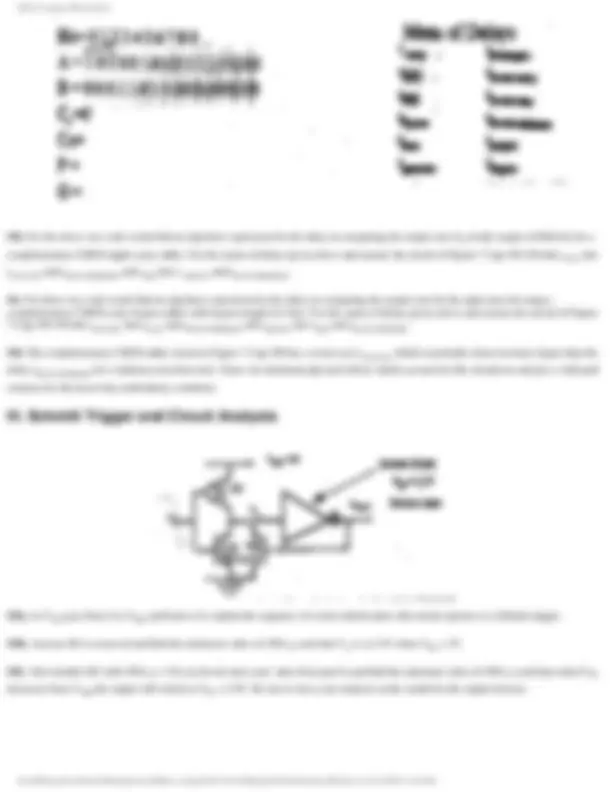



Study with the several resources on Docsity

Earn points by helping other students or get them with a premium plan


Prepare for your exams
Study with the several resources on Docsity

Earn points to download
Earn points by helping other students or get them with a premium plan
Community
Ask the community for help and clear up your study doubts
Discover the best universities in your country according to Docsity users
Free resources
Download our free guides on studying techniques, anxiety management strategies, and thesis advice from Docsity tutors
Main points of this exam paper are: Latches, Clock Transistors, Inputs, Specifying, Evaluation, Functions, Dynamic Logic Circuit
Typology: Exams
1 / 2

This page cannot be seen from the preview
Don't miss anything!


EECS 141 spring 1999 mid-term 2
1a) For inputs, A, B, C, D, and E implement the following functions for the X, Y, and Z nodes by drawing the transistor circuits and specifying the inputs to the clock transistors (as phi or phi bar) in the dynamic logic circuit below. Use the convention that phi is high for evaluation. Do not consider the latches for part a).
X(bar) = A + B Y(bar) = CD + X(bar) Z(bar) = Y + E
1b) Provide latching for the dynamic logic below by placing the minimum number of latch circuits around the logic in the boxes provided and specifying inputs to the clock transistors. Assume only input A arrives through the latch on the input side.
1c) Consider the operation of this circuit, which among its four gates, includes a single static inverter stage. In the presence of clock overlap will this circuit operate correctly? Explain using the sequence of events which occurs for the case of phi going low before phi bar goes high.
IIa. Find carry input Cij, output Coj , the propogate P and generate G logic values associated with each bit in adding the following two 16 bit
words. Assume the least significant bit is on the left as indicated by the bit number.
file:///C|/Documents%20and%20Settings/Jason%20Rafter...neering%20141%20-%20Spring%201999-Neureuther-MT2.htm (1 of 2)1/27/2007 4:16:26 PM
EECS 141 spring 1999 mid-term 2
IIb. For the above two code words find an algebraic expression for the delay in computing the output sum S 4 (really output of fifth bit) for a
complementary CMOS ripple-carry adder. Use the menu of delays given above and assume the circuit of Figure 7.5 pp 389. Divide tcarry into
tcarry bar and tinvert-minimum and tsum into t (^) sum bar and tinvert-minimum.
IIc. For these two code words find an algebraic expression for the delay in computing the output sum for the right most bit using a complementary CMOS carry-bypass adder with bypass length of 4 bits. Use the menu of delays given above and assume the circuit of Figure 7.5 pp 389. Divide tcarry bar into t (^) carry and tinvert-minimum and tsum bar into tsum and tinvert-minimum.
IId. The complementary CMOS adder circuit in Figure 7.5 pp 389 has a worst case tcarry bar which is probably about ten times larger than the
delay t (^) invert-minimum for a minimum sized inverter. Name two dominant physical effects which account for this slowdown and give a ball park
estimate for the factor they individualy contribute.
IIIa. As VIN goes from 0 to VDD and back to 0, explain the sequence of events which makes this circuit operate as a Schmitt trigger.
IIIb. Assume M3 is removed and find the minimum value of (W/L) 2 such that Vx is at 2.5V when VIN = 3V.
IIIc. Now include M3 with (W/L) 3 = 5 if you do not trust your value from part b) and find the minimum value of (W/L) 3 such that when VIN
decreases from V (^) DD the output will switch at VIN = 2.0V. Be sure to base your analysis on the model for the output inverter.
file:///C|/Documents%20and%20Settings/Jason%20Rafter...neering%20141%20-%20Spring%201999-Neureuther-MT2.htm (2 of 2)1/27/2007 4:16:26 PM